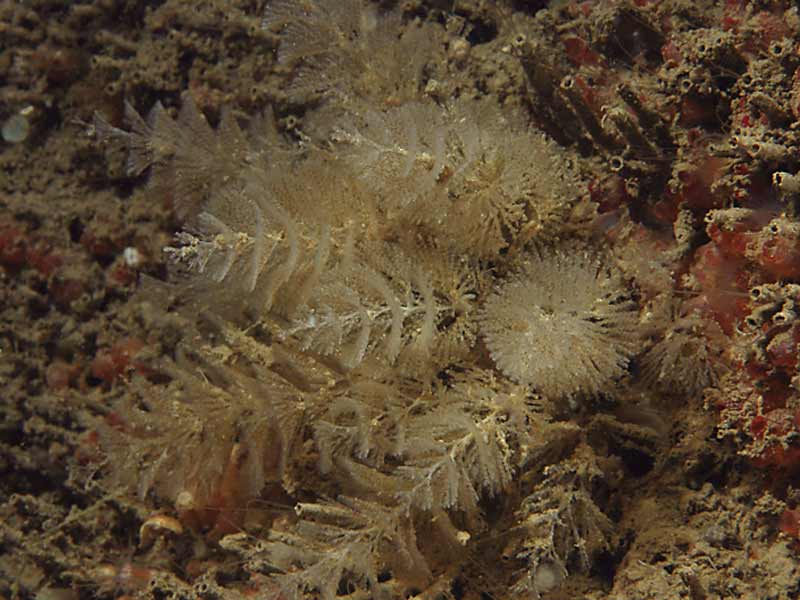Feather bryozoan (Crisularia plumosa)
Distribution data supplied by the Ocean Biodiversity Information System (OBIS). To interrogate UK data visit the NBN Atlas.Map Help
| Researched by | Sonia Rowley | Refereed by | Admin |
| Authority | (Pallas, 1766) | ||
| Other common names | - | Synonyms | Bugula plumosa Pallas 1766 |
Summary
Description
The buff to orange colonies of Crisularia plumosa comprise several feathery tufts up to 8 cm in height. Each 'tuft' consists of spirally arranged branches that arise from a mass of tangled rhizoids. The slender zooids are ca 0.4-0.5 x 0.1-0.2 mm and arranged in two rows along the branches. In this species, over three-quarters of the frontal surface has a membranous covering. The zooids outer margin protrudes distally to form an unjointed spine. No spine is present on the inner margin. The avicularia are very small, shorter than the width of the zooids and have a slightly down curved lip (beak). The polypides have 14 tentacles.
Recorded distribution in Britain and Ireland
This species is widely distributed throughout the British Isles and Ireland but recorded predominantly in the south.Global distribution
-Habitat
This species can be found in small groups or as a 'turf' on rocks or other hard surfaces, especially on harbour walls and pier pilings. It is a littoral and sublittoral species down to >50 m depth.Depth range
-Identifying features
- Colonies are buff to orange in colour.
- Colonies consisting of several spirally branched tufts up to 8 cm in height.
- The zooids are arranged in two rows along the branches.
- The zooids are slender ca 0.4-0.5 x 0.1-0.2 mm.
- An unjointed spine is present on the outer margin of the zooids.
- The avicularia are very small.
- Polypides have 14 tentacles.
Additional information
Crisularia plumosa may be mistaken for Bugulina flabellata due to their similar tufted appearance although Bugulina flabellata has much broader flattened 'tufts'. Like most other bryozoan species, Crisularia plumosa is predated upon by various species of nudibranchs such as Antiopella cristata and Polycera faeroensis. Crisularia plumosa is primarily a southern species replaced mainly by Crisularia purpurotincta in the north of the British Isles.
The ovicells of this species appear globular when full of embryos. The embryos are yellow and present from July to September. The first zooid to form a colony after metamorphosis from a free-swimming larvae (known as the ancestrula) is vase-shaped, having a circular, terminal frontal membrane with no surrounding spines (Ryland & Hayward, 1977).
Listed by
- none -
Bibliography
Bruce, J.R., Colman, J.S. & Jones, N.S., 1963. Marine fauna of the Isle of Man. Liverpool: Liverpool University Press.
Costello, M.J., Bouchet, P., Boxshall, G., Emblow, C. & Vanden Berghe, E., 2004. European Register of Marine Species [On-line]. http://www.marbef.org/data/erms.php,
Foster-Smith, J. (ed.), 2000. The marine fauna and flora of the Cullercoats District. Marine species records for the North East Coast of England. Sunderland: Penshaw Press, for the Dove Marine Laboratory, University of Newcastle upon Tyne.
Gibson, R., Hextall, B. & Rogers, A., 2001. Photographic guide to the sea and seashore life of Britain and north-west Europe. Oxford: Oxford University Press.
Hayward, P.J. & Ryland, J.S. (ed.) 1995b. Handbook of the marine fauna of North-West Europe. Oxford: Oxford University Press.
Howson, C.M. & Picton, B.E., 1997. The species directory of the marine fauna and flora of the British Isles and surrounding seas. Belfast: Ulster Museum. [Ulster Museum publication, no. 276.]
MarLIN (Marine Life Information Network), 2005. SEArchable BEnthic Data (SEABED) Map [on-line]. Data Access Sub-programme, Marine Life Information Network for Britian and Ireland http://www.marlin.ac.uk,
MBA (Marine Biological Association), 1957. Plymouth Marine Fauna. Plymouth: Marine Biological Association of the United Kingdom.
Naylor, P., 2003. Great British Marine Animals. Plymouth: Sound Diving Publications.
Picton, B. E. & Morrow, C.C., 1994. A Field Guide to the Nudibranchs of the British Isles. London: Immel Publishing Ltd.
Ryland, J.S. & Hayward, P.J. 1977. British anascan bryozoans. London: Academic Press. Synopses of the British Fauna no. 10.
Wood, E. (ed.), 1988. Sea Life of Britain and Ireland. Marine Conservation Society. IMMEL Publishing, London
Datasets
Fenwick, 2018. Aphotomarine. Occurrence dataset http://www.aphotomarine.com/index.html Accessed via NBNAtlas.org on 2018-10-01
NBN (National Biodiversity Network) Atlas. Available from: https://www.nbnatlas.org.
OBIS (Ocean Biodiversity Information System), 2024. Global map of species distribution using gridded data. Available from: Ocean Biogeographic Information System. www.iobis.org. Accessed: 2024-04-25
Citation
This review can be cited as:
Last Updated: 12/09/2007




